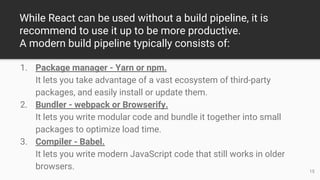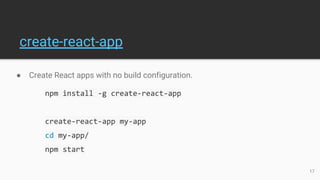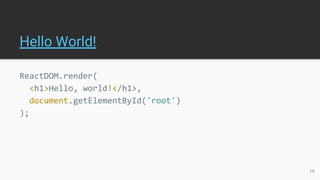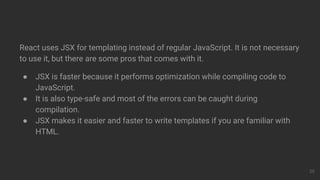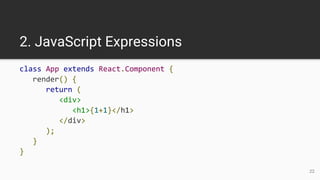Introduction to React JS
- 1. React JS Introduction to React
- 2. What is React? React is a declarative, efficient, and flexible JavaScript library for building user interfaces. 2
- 5. Build components, not templates ● UI Components are the cohesive units ● UI description and UI logic ● Full power of JavaScript to express UI 5
- 6. React challenges established best practices in traditional MVC framework React can also render on the server using Node, and it can power native apps using React Native. React implements one-way reactive data flow which reduces boilerplate and is easier to reason about than traditional data binding. 6
- 8. 1. JSX JSX is JavaScript syntax extension. It isn't necessary to use JSX in React development, but it is recommended. 8
- 9. 2. Components React is all about components. You need to think of everything as a component. This will help you to maintain the code when working on larger scale projects. 9
- 10. 3. Unidirectional data flow and Flux React implements one way data flow which makes it easy to reason about your app. Flux is a pattern that helps keeping your data unidirectional 10
- 11. 4. License React is licensed under the Facebook Inc. Documentation is licensed under CC BY 4.0. 11
- 12. React Advantages ● React uses virtual DOM which is JavaScript object. This will improve apps performance since JavaScript virtual DOM is faster than the regular DOM. ● React can be used on client and server side. ● Component and Data patterns improve readability which helps to maintain larger apps. ● React can be used with other frameworks 12
- 13. React Limitations ● React only covers view layer of the app so you still need to choose other technologies to get a complete tooling set for development. ● React is using inline templating and JSX. This can seem awkward to some developers. 13
- 15. While React can be used without a build pipeline, it is recommend to use it up to be more productive. A modern build pipeline typically consists of: 1. Package manager - Yarn or npm. It lets you take advantage of a vast ecosystem of third-party packages, and easily install or update them. 2. Bundler - webpack or Browserify. It lets you write modular code and bundle it together into small packages to optimize load time. 3. Compiler - Babel. It lets you write modern JavaScript code that still works in older browsers. 15
- 16. Using a CDN <script src="https://unpkg.com/react@15/dist/react.min.js"></script> <script src="https://unpkg.com/react-dom@15/dist/react-dom.min.js"></script> 16
- 17. create-react-app ● Create React apps with no build configuration. npm install -g create-react-app create-react-app my-app cd my-app/ npm start 17
- 18. Create React App is the best way to start building a new React single page application. It sets up your development environment so that you can use the latest JavaScript features, provides a nice developer experience, and optimizes your app for production. Create React App doesn't handle backend logic or databases; it just creates a frontend build pipeline, so you can use it with any backend you want. It uses webpack, Babel and ESLint under the hood, but configures them for you. 18
- 20. React uses JSX for templating instead of regular JavaScript. It is not necessary to use it, but there are some pros that comes with it. ● JSX is faster because it performs optimization while compiling code to JavaScript. ● It is also type-safe and most of the errors can be caught during compilation. ● JSX makes it easier and faster to write templates if you are familiar with HTML. 20
- 21. 1. Nested Elements class App extends React.Component { render() { return ( <div> <h1>Header</h1> <h2>Content</h2> <p>This is the content!!!</p> </div> ); } } 21
- 22. 2. JavaScript Expressions class App extends React.Component { render() { return ( <div> <h1>{1+1}</h1> </div> ); } } 22
- 23. 3. Styling class App extends React.Component { render() { var myStyle = { fontSize: 100, color: '#FF0000' } return ( <div> <h1 style = {myStyle}>Header</h1> </div> ); } } 23
- 24. Components & Props Components let you split the UI into independent, reusable pieces, and think about each piece in isolation. They accept arbitrary inputs (called "props") and return React elements describing what should appear on the screen. 24
- 25. class Welcome extends React.Component { render() { return <h1>Hello, {this.props.name}</h1>; } } function Welcome(props) { return <h1>Hello, {props.name}</h1>; } With ES6Javascript function 25
- 26. But Props are Read-Only! All React components must act like pure functions with respect to their props. Components can be reused 26
- 27. State allows React components to change their output over time in response to user actions, network responses, and anything else, without violating this rule. State 27
- 28. class App extends React.Component { constructor(props) { super(props); this.state = { header: "Header from state...", "content": "Content from state..." } } render() { return ( <div> <h1>{this.state.header}</h1> <h2>{this.state.content}</h2> </div> ); } } export default App; State is the place where the data comes from. Always try to make your state as simple as possible and minimize number of stateful components. If you have, for example, ten components that need data from the state, you should create one container component that will keep the state for all of them. 28
- 29. 1. Components 2. Backend 3. Maintainable code 4. Learning curve Thinking in React 29
- 30. ● React is a library for building composable user interfaces. ● It encourages the creation of reusable UI components which present data that changes over time. ● Lots of people use React as the V in MVC. ● React abstracts away the DOM from you, giving a simpler programming model and better performance. ● React can also render on the server using Node, and it can power native apps using React Native. ● Implements one-way reactive data flow which reduces boilerplate and is easier to reason about than traditional data binding. Summary 30
- 31. Thank You! 31














